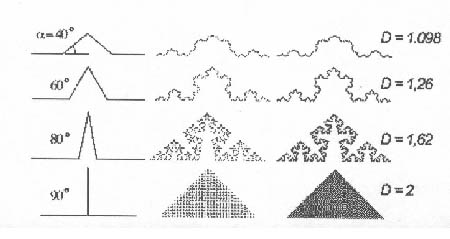
Fractals are infinitly complex curves, within a finite space. That is where the key notion of fractional dimension comes from, it is not anymore an integer.
How would you measure the length of the Britany's cost ?
Take the atlantic shoreline of the United States. On a globe, it could look anywhere from two to four thousand miles long, depending on how smooth the coastline was forced to be, due to the low detail level of a world map. A smaller scaled map of the Atlantic seabord might show some of the larger bays, making the coastline much longer, though the actual distance between the northern and southern boundaries of the coast remained the same. A human being walking along could not leave oumost major inlets or curves where the water meets the sand, and would then walk even a greater distance than indicated on the map. An ant has to walk around every small tiny inlet as she could not walk over them, making many more turns and direction changes resulting in an even longer voyage. Once again the distance between point a and point b has not changed, but the level of details has. An electron travelling the same path would have to maneuver his way around land atoms on one side and sea atoms on the other making thousand of millions of tiny turns and shifts, and could not trace over the coast as easilly as the ant had supposidly done tediously only a moment before. Assuming that nature is infinitely detailed, the shoreline between point a and point b is infinite, though the area bounded by the water is finite. A shoreline exists in a fractional dimension.
In the field of mathematics, it was generrally accepted that figures either existed in 0 dimensions like points, 1 dimension like lines, 2 dimensons like squares and sections of planes, or 3 dimensions like cubes and spheres. Early in this century a mathematician named Cantor decided to challenge mathematicians to imagine a thing constructed in a curious, recursive manner. He took a line segment of length x He decided to take out the middle third as his first step in building his little object. Then he divided the remainning segments by three as well, taking out the middle thirds of those. If one kept doing that forever, he would not end up with a finite zero-dimensinal set. There would be an infinite number of them, and they would not really be points but bits of a line segment cut to length of infinite smallness. This random collection of points was not one-dimensional either, as we'd begun by cutting it up, and infinite iteration of that process would never lead to anything capable of having a length (a one-dimensional measurement). So what is the dimension of this new object ?
The following diagram shows us how we need to consider other dimensions between dimension 1 and 2; fractal dimensions. Using the Von Koch curve.

D has been calculated from a mathematical formula, D=log 2/log (2 cos ß/2).
When the angle is 90°, the triangle is completely covered, so it is a surface and it's dimension is 2. If the angle is 0°, we obtain a line and the dimension is 1, in between, the dimension is fractional.
In the newer forms of maths dealing with the fourth dimension and all the fractional ones around it, we see a way to describe the chaotic elements of nature and our universe.